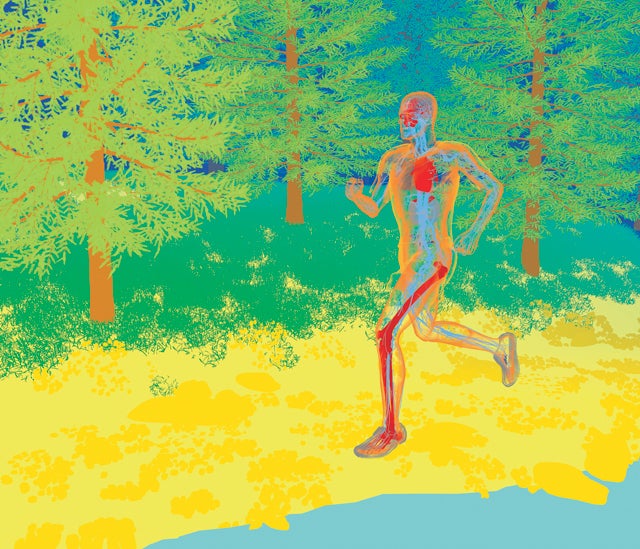In a 2011 study of 128 college runners, researchers found that “surrounding greenness” was an indicator of better athletic performance. Other studies have shown that exercising in nature results in less fatigue, reduced anxiety, less hostility, more positive thoughts, and an overall feeling of invigoration.
The Nature Cure
The surprising health benefits of the great outdoors.The ║┌┴¤│ď╣¤═° RX
Natural settings alleviate directed-attention fatigue (DAF), which occurs when the brain’s prefrontal cortex must constantly manage competing stimuli. DAF can cause impatience and irritability. Gazing at clouds and trees restores both mood and cognitive function.
Running on natural surfaces, specifically grass, is 15 to 35 percent easier on your jointsÔÇöespecially your kneesÔÇöthan running on pavement and also lessens the impact on the plantar fascia, the sensitive tissue that supports your arch. The shock absorption also makes your muscles work harder, so you get a better workout.
When you’re relaxing in nature, your adrenal cortex produces less of the hormone cortisol, which activates the body’s stress response. Prolonged periods of stress can also shrink the hippocampus, which is where we form and store memories. By contrast, less stress enhances neuroplasticity, the brain’s ability to form new connections.
Recent research analysis found that for every hour per week a child spends outdoors, the chance of developing near-sightedness falls by two percent. Some studies have also found that spending time outdoors may slow the progression of myopia in adults.
Studies have shown that being in close proximity to water can significantly lift people’s moods.
Soil bacteria and other microorganisms that we passively inhale can alter hormone levels to improve mood, decrease anxiety, and improve cognitive function. One study found that mice that ingested soil bacteria called Mycobacterium vaccae were able to navigate a maze twice as fast as other mice.
Sunlight exposure boosts production of white blood cells, which helps the body combat disease. Sunlight also increases the number of red blood cells, thereby increasing your blood’s oxygen-carrying capacity and improving muscular endurance.
When sunlight hits your eyes, your optic nerve directs your brain’s pineal gland to decrease production of melatonin, the hormone that regulates circadian rhythmsÔÇöour wake-sleep cyclesÔÇöand boost serotonin, a neurotransmitter associated with mood and appetite.
The sun’s ultraviolet energy converts cholesterol in your skin into vitamin D, which increases calcium absorption during digestion, producing stronger, denser bones. Regular exposure to sunlight has been shown to decrease blood cholesterol levels by more than 30 percent.
Scientists believe that biologically diverse environments like farms and forests harbor more friendly microbes, which colonize our bodies and protect against inflammatory disorders. A recent study found that teenagers living in the country has fewer incidences of allergies than those in urban centers.
DNA methylationÔÇöbiochemical changes that are critical for gene expressionÔÇömay differ in people raised in cities over rural areas, according to recent hypotheses. While the potential impacts aren’t clear, some studies suggest that the methylation linked to urban life could contribute to depression.
Phytoncides, compounds emitted by plants and trees, reduce blood pressure, decrease stress hormone levels, and boost production of so-called natural killer immune cells, which fight tumors and viruses.
Several studies indicate that spending time in nature lowers blood pressure, and one found that it lowers blood sugar levels in diabetes patients.


